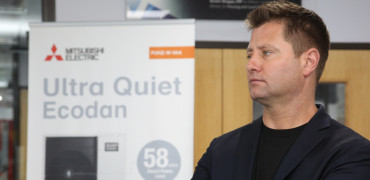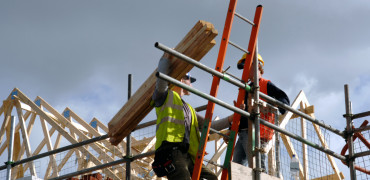The nation is in lockdown from COVID-19 and my heart goes out to anyone suffering as a result. Our eternal thanks should also go to those helping keep society going including all the unseen people such as shop workers, refuse collectors and delivery guys, in addition to the absolute heroes of the NHS, police and fire service.
I’m hunkering down and keeping myself and my family as safe as I can and I hope you do to. In the meantime, I’m looking beyond this crisis and focusing on getting better homes for everyone, should we ever find ourselves in this position again. Keep safe everyone.
A wet history
If we think about the way homes have been built over the last couple of thousand years you can understand why building materials are used the way they are and why we have so many wet trades.
Very early building materials were natural but perishable, such as using leaves, branches, soil and animal hides. Later, materials we still taken from the land, but became more durable where we used stone, clay and bricks.
Most of these either needed water to be manufactured in the first place or they required wet bonding materials, such as mortar, to join them together.
Wet trades have been used to the benefit of construction for thousands of years. Even the Romans created new forms of architecture because of their advancements in very early cement and concrete technology.
I don’t think I’ve ever felt more disappointed in the homes that are being thrown up.
Regional variants
Throughout Britain regional variations in home building and architecture came about because we used materials from that local area. It was the materials that gave homes their distinctive look and unique character. A home in the Cotswolds has always been very different to one built in the Lake District.
As I’m writing this blog I’ve taken a moment to step away from my computer to take a look at the ‘Geological Map of the British Isles’ I have hanging on my study wall. That alone is a fascinating insight into the wonderful number of natural resources we have in the ground that weave their way through our small island.
Chalk, Weald Clay, Granite, Syenite, Magnesium Limestone, Sandstone, Slate, Basalt and Greenstone to name but a few.
All needed to be bonded together somehow unless dry stone walling was adopted.
Then in the 19th and 20th centuries more synthetic materials were developed, such as metals, advanced forms of concrete and glass as well as plastics.
But, still when it comes to home building we used concrete blocks and bricks that need to be bonded together.
Globalisation
Globalisation is now the norm and the global trade dominates the home building industry.
Forget about local materials and regional differences in our homes, most of us would not be able to tell which country a material or product had come never mind which region.
It probably didn’t even come from Britain! And architectural styles are globally all over the place!
Once architecture was deeply rooted to place, but not anymore. I stayed in a modern house in Thailand last year that looked very similar in design to one I’d stayed in in South America and another I’d stayed in in California!
What a shame that is.
Shocking
But, back in the UK and back to the mass housebuilding industry.
I don’t think I’ve ever felt more disappointed in the way we design, engineer and build the majority of homes that are being thrown up.
The designs are average at best, the place making is poor, the environmental standards are rubbish and I’ve been shocked by some of the building quality standards.
But, what still amazes me is the process of how we build and the number of wet trades we use. It is unbelievably slow and inefficient.
Think about it. We dig a trench and we pour concrete foundations that takes a lot of water and drying time. We then lay blocks and bricks to build walls up to eaves height. This takes a lot of sand and cement and a lot of water and drying time.
Only when we get these walls up can we put the roof on. In this country, with our weather, we need to get the roof on as quickly as possible. But, it takes ages.
Even then we aren’t wind and water tight yet because we are waiting for the windows to arrive on site.
And then the wet trades continue...
Wet, wet, wet
Concrete floor slabs are poured after the foundation walls pop up past ground level.
Wet sand and cement screeds are poured onto the slabs when the roof is on.
We plaster walls after first fix plumbing and electrics trying to get the walls to look as smooth as a manufactured board.
We bond tiles in bathrooms and wet grout them together.
We get painters and decorators to put multiple coats of paint on walls and ceilings, while there is still dust in the air from all the other work going on around them – multiple traders on top of each other all trying to do lots of things at the same time in the rush and panic to get a house built and sold as quickly as possible to meet the demand.
Every wet trade taking a lot of time to finish and dry.
All happening on a messy building site in the Great British outdoors where you can have four seasons in one day!
It all seems bonkers to me!
There is another way
Let’s imagine a different way of building a house.
Let’s imagine there is a beautiful factory where homes can be built in a very safe, clean, tidy and protected environment.
Let’s imagine a fantastically efficient supply chain where all of the products to need to put a house together arrive bang on time when you need them.
Imagine a home that is designed and engineered to the highest possible manufacturing standards after a rigorous period of research, development and testing.
Imagine homes that are life transforming and make us feel healthy and happy.
Imagine homes that a super eco-friendly, zero carbon, insulated way beyond the current building regulations and have the very best renewable energy products integrated into them and not just bolted onto the building as an afterthought.
Imagine a factory floor full of highly skilled operatives and engineers of all ages, sexes, abilities and disabilities brilliantly working together on a carefully co-ordinated production line.
Imagine 3 x 8 hour shifts so the factory was working at capacity 24 hours a days to meet the nation’s demand for the very best homes.
Imagine a fully finished home rolling off the end of the production line with no defects or snags whatsoever. The highest quality home, in all respects, that the UK Advanced Manufacturing industry has built in the most efficient and productive way imaginable.
Getting out of the dark ages
I’ve been told by the cynics that this is impossible.
Well I’m sure somebody said the same in the 1960’s when we sent humans to the moon in a tin can that had less technology inside it than the first ever iPhone had!
We can do this and we must, because the way we build houses at the moment is by a home building industry stuck in the dark ages.
George Clarke is an architect, writer, lecturer and TV presenter, and a founder of TV production company Amazing Productions.




